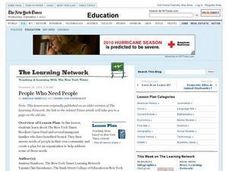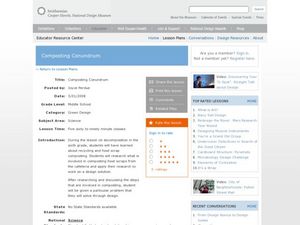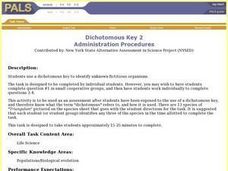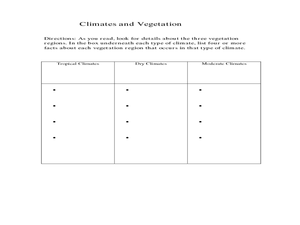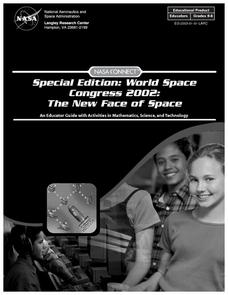Curated OER
Alien Invasions
Students create an educational pamphlet on the origins, spread and impact of invasive plant species in their community.
Curated OER
Causes and Effects
Students investigate one family's volunteer tourism experience and the international volunteer organizations to create a community guide to helping those in need around the world.
Curated OER
Are Viruses Alive: Sample Socratic Questions
Students comprehend the definition and uniqueness of life and its complexities. They examine what characteristics constitute a living organism. Students recognize the extent of the role viruses play in the movement and molding of life as...
Curated OER
People Who Need People
Students study The New York Times Neediest Cases Fund and several immigrant families who have benefited from it. They assess needs of people in their own community and create a plan for an organization to help address some of those needs.
Curated OER
Vertebrate Dioramas
Students are able to describe the development of their chosen form of vertebrate life from the past to the present in a four to six page typed paper. They explain the use of phylogenetic tree. Students use the phylogenetic tree to...
Curated OER
Vertebrate Dioramas
Students describe the development of their chosen form of vertebrate life from the past to the present in a four to six page paper. They explain the use of a phylogenetic tree, and use this to exemplify an organism's evolutionary change...
Curated OER
Composting Conundrum
Young scholars research cafeteria composting. In this composting lesson, students design a vessel that would allow the cafeteria staff to collect food scraps for composting. Then young scholars build a prototype and present it to the...
Curated OER
Drawing a "Life Map"
Students create an autobiography. In this writing lesson, students use a life map as a graphic organizer to develop their autobiography.
Curated OER
The Great Kapok Tree- Teaching About Conflict in Literature
Students identify the plot of a text. In this literature lesson plan, students listen to the book The Great Kapok Tree and identify the problem and solution. A graphic organizer is used to help reinforce the concept.
Curated OER
Dichotomous Key 2
Students use a dichotomous key to identify unknown fictitious organisms in an assessment designed to be used after a discussion on the use of a dichotomous keys has occurred. Follow up questions about key included.
Curated OER
Physical Geography- Climate
Sixth graders explore different climates. In this compare and contrast instructional activity, 6th graders look at the differences in climates of America and Europe. Students use KWL charts and graphic organizers to record information...
Curated OER
Web of Life - Role-Playing
Young scholars role-play how organisms adapt to their environment. They play 20 questions with plant and animal habitats. They create a web of life to demonstrate how each plant and animal relies on the other for survival.
Curated OER
Unit Plan Template
Learners research the adaptations of desert animals and build their research skills. In this the adaptations of desert animals activity, students describe major factors that desert animals have on their habitat. Learners...
Curated OER
Special Edition: World Space Congress 2002: The New Face of Space
Students experience and study how space offers expanding resources for commerce, science, technology and education. They view how advances in space can and do improve life on Earth. Each student views a geological exploration within this...
Curated OER
SOIL
Second graders name the various materials that comprise soil, including weathered rock and other organic matter; and explain that soils differ in their color, texture, capacity to retain water, and ability to support the growth of many...
Curated OER
Emergency Preparedness
Learners are introduced to governmental and humanitarian responses to disasters. They research organizations such as FEMA and the Red Cross. They examine their local National Guard unit as well.
Curated OER
Bureau Stats
Students explore the role of bureaucracy in United States government; they then examine the history, leadership, organization, and goals of executive agencies.
Curated OER
The Water Cycle
Fifth graders identify organisms and processes involved in three cycles: the water cycle, the carbon cycle, and the nitrogen cycle. They produce a pictorial or abstract water cycle, and appropriately place life forms onto an existing...
Curated OER
Science: It's a Nutty World!
Fourth graders conduct Internet research to explore various peanut-related topics. Among topics they investigate are: agriculture, scientific uses, and the research of George Washington Carver. As a technology component, 4th graders...
Curated OER
What's Bugging You?
Students examine the effects of pests on other organisms, crops, and the environment. they construct an insect observation chamber and discover how some insects can be pests in some situations and beneficial in others. They write "pest...
Curated OER
World Statistic Day
Eleventh graders collect data about the state they live in. In this statistics lesson, 11th graders collect and analyze data as they compare themselves to students in other states. They analyze data about a person's education level, and...
Curated OER
Student Samples of Definition Poems
In this poetry writing worksheet, students learn to write a definition poem by first studying 3 student samples of poems. Then students follow the directions to fill out a definition poem web on a graphic organizer chart. Students write...
Curated OER
Trying Teens
Students explore the court cases and legal organizations that were instrumental in creating a system of juvenile justice in the United States, then present their findings in a composite timeline.
Curated OER
Marching On
Students explore the increasingly diverse civil rights movement by researching and profiling its key issues, main organizations, and top leaders.(August 25, 2003)



